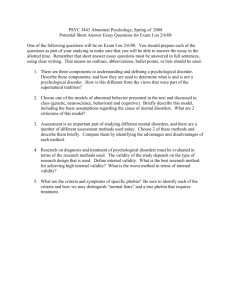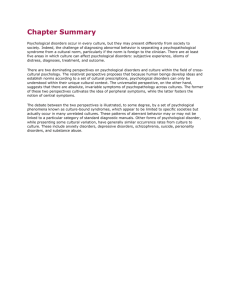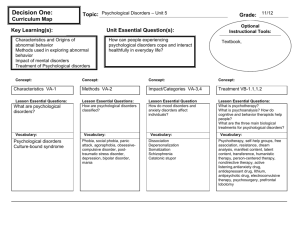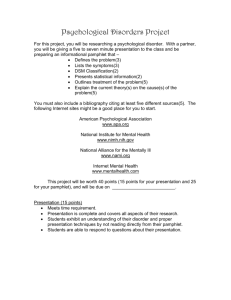Abnormal Behavior
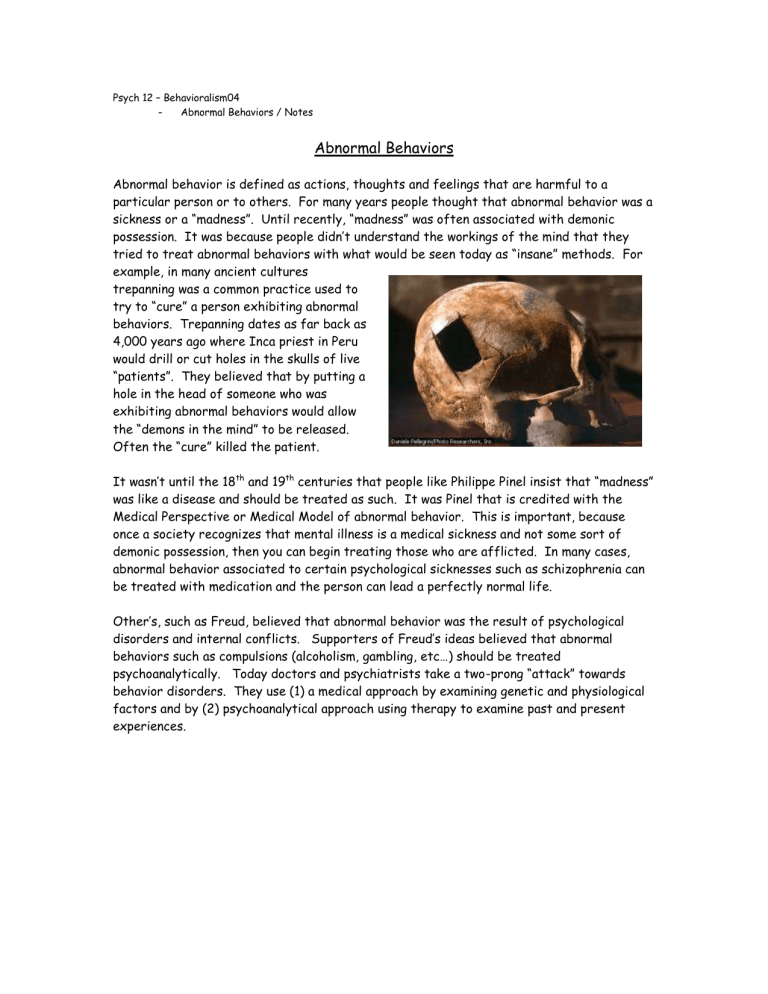
Psych 12 – Behavioralism04
Abnormal Behaviors / Notes
Abnormal Behaviors
Abnormal behavior is defined as actions, thoughts and feelings that are harmful to a particular person or to others. For many years people thought that abnormal behavior was a sickness or a “madness”. Until recently, “madness” was often associated with demonic possession. It was because people didn’t understand the workings of the mind that they tried to treat abnormal behaviors with what would be seen today as “insane” methods. For example, in many ancient cultures trepanning was a common practice used to try to “cure” a person exhibiting abnormal behaviors. Trepanning dates as far back as
4,000 years ago where Inca priest in Peru would drill or cut holes in the skulls of live
“patients”. They believed that by putting a hole in the head of someone who was exhibiting abnormal behaviors would allow the “demons in the mind” to be released.
Often the “cure” killed the patient.
It wasn’t until the 18 th and 19 th centuries that people like Philippe Pinel insist that “madness” was like a disease and should be treated as such. It was Pinel that is credited with the
Medical Perspective or Medical Model of abnormal behavior. This is important, because once a society recognizes that mental illness is a medical sickness and not some sort of demonic possession, then you can begin treating those who are afflicted. In many cases, abnormal behavior associated to certain psychological sicknesses such as schizophrenia can be treated with medication and the person can lead a perfectly normal life.
Other’s, such as Freud, believed that abnormal behavior was the result of psychological disorders and internal conflicts. Supporters of Freud’s ideas believed that abnormal behaviors such as compulsions (alcoholism, gambling, etc…) should be treated psychoanalytically. Today doctors and psychiatrists take a two-prong “attack” towards behavior disorders. They use (1) a medical approach by examining genetic and physiological factors and by (2) psychoanalytical approach using therapy to examine past and present experiences.
Psych 12 – Behavioralism04
Abnormal Behaviors
Abnormal Behavior
Directions: READ the excerpt Abnormal Behavior/Psychological Disorders from Psychology by David G. Myer, and answer the following questions;
1. Use a dictionary or the internet to define the following vocabulary words;
Atypical Maladaptive Trepanning
2. On a separate piece of paper, answer the following questions using COMPLETE
SENTENCES; a.
Using your own words, describe how mental health workers identify people as being psychologically disordered as opposed to just “different”. In your mind what is the main determinate that you would use to label a person as having a “disorder”. (2 mks for quality of response and evidence of understanding) b.
Using your own words, describe the differences between the medical model and the psychoanalytical treatment of mental disorders. Who was responsible for the creation of the medical model? (2 mks for quality of response and evidence of understanding) c.
Provide your own example of how a medical, or biological problem can result in a mental disorder. (2 mks for quality of response) d.
According to the author (Myer) what approach should mental health practitioners take when treating a patient? (2 mks for evidence of thought and effort)
3.
In your opinion what is wrong with “labeling” a person with a disorder?
What is useful?
You will be marked out of 5 for your ability to produce a thoughtful response with examples to back up your opinion.
Total Marks: ___/ 16
Psych 12 – Behavioralism04
Abnormal Behaviors
Abnormal Behavior/Psychological Disorders
Excerpt from Psychology By David G. Myer
Most people are fascinated by the exceptional, the unusual, and the abnormal. “The sun shines and warms and lights us and we have no curiosity to know why this is so,” observed
Ralph Waldo Emerson, “but we ask the reason of all evil, of pain, and hunger, and mosquitoes and silly people.”
Why this fascination with disturbed people? Perhaps in them we often see something of ourselves. At various moments, all of us feel, think, or act as disturbed people do much of the time. We too, feel, think, or act as disturbed people do much of the time. We too, may be anxious, depressed, withdrawn, suspicious, deluded, or antisocial, although less intensely and enduringly. Studying psychological disorders may therefore at time evoke an eerie sense of self-recognition that illuminates our own personality dynamics. “To study the abnormal is the best way of understanding the normal,” proposed William James.
Another reason for our curiosity is that so many of us have felt, either personally or through friends or family members, the bewilderment and the pain of a psychological disorder. In all likelihood, you or someone you care about has been disabled by unexplained physical symptoms, overwhelmed by irrational fears, or paralyzed by the feeling that life is not worth living. Each year there are near 1.7 million inpatient admissions to U.S. mental hospitals and psychiatric units. Some 2.4 million others, often troubled but disabled, seek help as outpatients form mental health organizations and clinics. Many more – 15 percent of
Americans, according to one government study – are judged to need such help. Nor are such problems peculiar to the United States. So far as we know, no human culture is free of the two terrible maladies of schizophrenia and depression. As members of the human family, few of us go through life unacquainted with the reality of psychological disturbance.
Perspectives on Psychological Disorders
Most people would agree that someone who is too depressed to get out of bed fore weeks at a time suffers a psychological disorder. But what about those who, having experienced a loss, are unable to resume their usual social activities? Where should we draw the line between normality and abnormality? How should we define psychological disorders? Equally important, how should we understand disorders – as a sicknesses that needs to be diagnosed and cured, or as a natural responses to a troubling environment? Finally, how might we classify disordered personalities? Can we do so in a way that allows us to help disturbed people and not merely stigmatize them with labels?
Defining Psychological Disorders
James Oliver Huberty had been hearing voices. He “talked with God,” his wife reported.
Although he had never been to Vietnam, he strode into San Ysidro, California, McDonald’s
restaurant one summer day in 1984 screaming, “I’ve killed a thousand in Vietnam and I’ll kill a thousand more.” In the next few minutes, before police gunned him down, Huberty gunned down 21 people.
At the end of World War II, James Forrestal, the first U.S. Secretary of Defense, became convinced that Israeli secret agents were following him. His suspiciousness struck his physicians as bizarre. They diagnosed him as mentally ill and confined him to an upper floor of Walter Reed Army Hospital. From there he plunged to his death. Although Forrestal had problems, it was later discovered that he was, in fact, being followed by Israeli agents, who feared he might secretly negotiate with representatives of Arab nations. As woody
Allen once said, even paranoids can have enemies.
Both the voices that Huberty heard and the degree of anxiety and depression that
Forrestal experienced were deviations from the normal. These were “abnormal” (atypical) perceptions. Being different from most other people is part of what it take to define a psychological disorder. As the reclusive poet Emily Dickenson observed in 1862;
Assent – and you are sane –
Demur – you’re straightaway dangerous –
And handled with a Chain.
Clearly, there is more to a disorder than being atypical. Olympic gold medalists are abnormal in their physical capabilities, and they are heroes. To be considered disordered, other people must find the atypical behaviour disturbing. Certainly the atypical behaviour of James Oliver Huberty is disturbing.
But standards of acceptability for behaviours vary. In some cultures, people routinely behave in ways (such as going around naked) that in other cultures would get them arrested.
In at least one cultural context – wartime – even mass killing may be viewed as heroic. One person’ homicidal “terrorist” is another person’s “freedom fighter.” Standards of acceptability vary not only from culture to culture but also from time to time. Two decades ago, the American Psychiatric Association dropped homosexuality as a disorder (because it is now believed unconnected with psychological problems). Later it added tobacco dependence (because it deemed smoking both addictive and self-destructive).
Atypical and disturbing behaviours are more likely to be considered disordered when judged as harmful. Indeed, many clinicians define disorders as behaviours that are maladaptive – as when a smoker’s nicotine dependence produces physical damage. Accordingly, even typical behaviours, such as the occasional depression that many college students feel, may signal a psychological disorder if they become disabling.
Finally, abnormal behaviour is most likely to be considered disordered when others find it rationally unjustifiable. Doctors attributed Forrestal’s suspicions to his imagination – and declared him disordered. Had he managed to convince others of his suspicions, he might have been helped, not merely labeled. James Olver Huberty claimed to hear voices and to talk with God, and we presume he was deranged. But Hollywood movie star Shirley MacLaine
can wear a crystal on her neck and say, “See the outer bubble of white light, watching you.
It is part of you,” and she is not considered disordered because enough people take her seriously. It is acceptable to be different from others if both you and they can justify or are undisturbed by the difference.
So mental health workers label behaviour psychologically disordered when the judge it
atypical, disturbing, maladaptive, and unjustifiable. Huberty’s behaviour met these criteria, so we have few doubts in judging him a disordered man.
Understanding Psychological Disorders
Imagine yourself living hundreds or thousands of years ago. How might you have accounted for the behaviour of a James Oliver Huberty? To explain puzzling behaviours, our ancestors often presumed that strange forces – the movements of the stars, godlike powers, or evil spirits – were at work. “The devil made him do it,” you might have said. The cure might have been to get rid of the evil force – by exorcising the demon or even by chipping a hole in the skull to allow the evil spirit to escape (trepanning). Until the last two centuries, “mad” people were sometimes caged under zoolike conditions or given “therapies” appropriate to a demon. Disordered people have been beaten, burned, and castrated. They have had teeth pulled, lengths of intestines removed, and the clitoris cauterized. They have had their own blood removed and replaced with transfusions of animal blood.
The Medical Perspective
In response to such brutal treatment, reformers such as Philippe Pinel (1745-1826) in
France insisted that madness was not demon possession but a disease that, like other diseases, we could treat and cure. For Pinel, treatment meant boosting patients’ morale by talking with them and by providing humane living conditions. When it was later discovered that an infectious brain disease, syphilis, produced a particular psychological disorder, people came to believe in physical causes for disorders and to search for medical treatments.
Today, Pinel’s medical perspective is familiar to us in the medical terminology of the mental health movement: A mental illness needs to be diagnosed on the basis of its symptoms and cured through therapy, which may include treatment in a psychiatric hospital. In the
1800’s, the assumption of this medical model – that psychological disorders are sicknesses – provided the impetus for much needed reforms. The “sick” were unchained and hospitals replaced asylums.
Equating psychological disorders with sickness does, however, have its critics, among them psychiatrist Thomas Szasz. Szasz believes that mental “illnesses” are socially, not medically, defined. When, for many years, Soviet psychiatrists diagnosed dissident citizens as “psychotic,” they were using medical metaphors to disguise their contempt for these people’s political ideas. Szasz concludes that in North America, too, mental health practitioners have too much authority in today’s society. When they demean people with the label “mentally ill,” their patients may begin to view themselves as “sick” and therefore
give up taking responsibility for coping with their problems. Many critics respond similarly to the ideas that alcohol abuse, drug abuse, overeating, gambling, and sexual promiscuity are addictive diseases – purely uncontrollable compulsions that require sympathy and treatment.
As we will see, labels can be self-fulfilling fables.
Despite such criticisms, the medical perspective survives and even gains renewed credibility form recent discoveries. Genetically influenced disorders in brain biochemistry have been linked with two f the most troubling psychological disorders, depression and schizophrenia, both of which are often treated medically.
Those who accept Freud’s psychoanalytic perspective agree that psychological disorders are sicknesses that have diagnosable and treatable causes. However, they insist that these causes may included psychological factors. We see such factors in the lingering emotional aftereffects of traumatic stress, such as that caused by rape and combat.
Alternative Perspectives
Psychologists who reject the “sickness” idea typically contend that all behaviour, whether called normal or disordered, arises from the interaction of nature (genetic and physiological factors) and nurture (past and present experiences). To presume that a person is “mentally ill” attributes the condition solely to an internal problem – to a “sickness” that must be found and cured. Maybe there is no deep, internal problem. Maybe there is instead a growth-blocking difficulty in the person’s environment, in the person’s current interpretations of events, or in the person’s bad habits and poor social skills.
When Native Americans were banished from their ancestral lands, forced onto reservations to live in poverty and unemployment, and deprived of personal control, the result was a rate of alcoholism more than five times that of other Americans. Because only some Native
Americans become alcoholic, the medical model would attribute such alcoholism to individual
“sickness”. A psychological perspective would emphasize the interaction between an individual’s vulnerability and a particular environment.
Evidence of environmental effects comes from links between disorder and culture.
Although major disorders such as depression and schizophrenia are universal, others are culture-bound. Different cultures have different stresses and produce different ways of coping. Anorexia nervosa, for example, is mostly a disorder of Western cultures.
Most mental health workers today assume that disorders are indeed influenced by genetic predispositions and physiological states. And by inner psychological dynamics. And by social circumstances. To get the whole picture, we need an interdisciplinary “bio-psycho-social” perspective.
